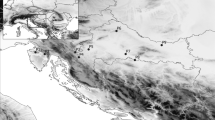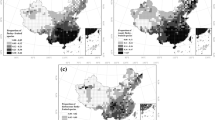Abstract
Fruit productivity of plant populations is an important variable in phenological and demographic studies, partly because it involves the quantification of total fruit production per infructescence (TFP). Therefore, a standardized fruit quantification method allows for comparisons between different studies. In this paper, we describe a reliable method to quantify TFP of Euterpe edulis Mart, a key stone species which provides great number of fruits to the frugivore assembly through the whole year. A total of 28 infructescences were collected: 10 in Restinga de Jurubatiba National Park and 18 in Serra dos Órgãos National Park, both in Rio de Janeiro, Brazil. Guided by procedures already described in previews studies, three metrics to compose a standardized method to estimate TFP were formulated. Based on a generalized linear mixed model (GLMM) selection to assess the best variables to estimate TFP, a fourth metric was formulated. Finally, the four following metrics were studied: TFPc (manual counting all fruits); TFPm (total fruit mass divided by mean fruit mass); TFPr (mean fruit produced per rachilla multiplied by number of rachillae); and TFPd (function of the best fitted GLMM). Low coefficients of variation highlight that fruit mass has a good repeatability within fruits produced by one infructescence, unlike the number of fruits produced by rachillae. Furthermore, TFPm has accurate and precise results when compared to the real TFP, and the low sampling effort demanded by this metric makes it ideal to integrate a standardized method to quantify the fruit production and be replicated in several habitat types.





Similar content being viewed by others
Notes
The pulp of fruits from infructescences collected at RJ were already attacked by fungi by the time we begun processing the material. In this case, we were able to count the fruits and test the other metrics, but as the fruit mass was compromised, we could not test TFPm using the infructescences harvested at RJ.
References
Akaike H (1987) Factor analysis and AIC. Psychometrika 52:371–386
Bai W, Sun X, Wang Z, Li L (2009) Nitrogen addition and rhizome severing modify clonal growth and reproductive modes of Leymus chinensis population. Plant Ecol 205:13–21. https://doi.org/10.1007/S11258-009-9595-2
Calvi GP, Piña-rodrigues FCM (2005) Fenologia e reproduçãode sementes de Euterpe edulis—Mart em trecho de floresta de altitude no município de Miguel Pereira—RJ. Rev Univ Rural 25:33–40
Coley PD, Bryant JP, Chapin FS (1985) Resource availability and plant antiherbivore defense. Science (1979) 230:895–899. https://doi.org/10.1126/SCIENCE.230.4728.895
da Silva JZ, dos Reis MS (2018) Fenologia reprodutiva e produção de frutos em Euterpe edulis (Martius). Ciencia Florestal 28:295–309. https://doi.org/10.5902/1980509831655
Danner M, Raseira M, Sasso S, Svariot ICS (2010) Repetibilidade de caracteres de fruto em araçazeiro e pitangueira. Ciência Rural 40:2086–2091
de Souza A, Prevedello JA (2019) Geographic distribution of the threatened palm Euterpe edulis Mart. in the Atlantic forest: implications for conservation. Oecol Aust 23:636–643. https://doi.org/10.4257/oeco.2019.2303.19
de Souza AC, Prevedello JA (2020) The importance of protected areas for overexploited plants: evidence from a biodiversity hotspot. Biol Conserv. https://doi.org/10.1016/j.biocon.2020.108482
de Mello T, Rosa TLM, Simões IM et al (2022) Reserve mobilization and in vitro germination of Euterpe edulis (Martius) seeds at different maturation stages. Trees Struct Funct 36:415–426. https://doi.org/10.1007/S00468-021-02216-6/FIGURES/8
de Souza AC, Portela RCQ, de Mattos EA (2018) Demographic processes limit upward altitudinal range expansion in a threatened tropical palm. Ecol Evol 8:12238–12249. https://doi.org/10.1002/ECE3.4686
Fornazzari IM (2011) Avaliação dos estádios de maturação dos frutos da palmeira Euterpe edulis Martius. Universidade Estadual de Ponta Grossa
Galetti M, Guevara R, Côrtes MC et al (2013) Functional extinction of birds drives rapid evolutionary changes in seed size. Science (1979) 340:1086–1090. https://doi.org/10.1126/science.1233774
Gatti MG, Campanello PI, Goldstein G (2011) Growth and leaf production in the tropical palm Euterpe edulis: light conditions versus developmental constraints. Flora Morphol Distrib Funct Ecol Plants 206:742–748. https://doi.org/10.1016/j.flora.2011.04.004
Giovannoni J (2001) Molecular biology of fruit maturation and ripening. Annu Rev Plant Physiol Plant Mol Biol 52:725–774
Giovannoni JJ (2007) Fruit ripening and its manipulation. In: Gan S (ed) Annual plant reviews, senescence processes in plants. Blackwell, pp 278–303
Gotelli N, Ellison A (2004) A primer of ecological statistics. Sinauer Associates, Sunderland
Harper JL (1981) Population biology of plants. Academic Press, London
Heidaryan E (2019) A note on model selection based on the percentage of accuracy-precision. J Energy Resour Technol Trans ASME. https://doi.org/10.1115/1.4041844/368236
Henderson A (2000) The genus Euterpe in Brazil. Sellowia 49:1–22
Henery ML, Westoby M (2001) Seed mass and seed nutrient content as predictors of seed output variation between species. Oikos 92:479–490. https://doi.org/10.1034/J.1600-0706.2001.920309.X
Henriques RPB, Araújo DSD, Hay JD (1986) Descrição e classificação dos tipos de vegetação da restinga de Carapebús. Rev Bras Bot 9:173–189
Laps RR (1996) Frugivoria e dispersão de sementes de palmiteiro (Euterpe eduls, Martius, Arecaceae) na Mata Atlântica, sul do estado de São Paulo. UNICAMP
Lei SA (2010) Benefits and costs of vegetative and sexual reproduction in perennial plants: a review of literature. J Ariz Nev Acad Sci 42:9–14. https://doi.org/10.2181/036.042.0103
Lorenzi H, Noblick LR, Kahn F, Ferreira E (2010) Flora Brasileira: arecaceae (Palmeiras). Instituto Plantarum de Estudos da Flora, Nova Odessa
Mangnusson A, Skaug H, Nielsen A, et al (2017) Package “glmmtmb.” cran.microsoft.com
Mantovani A, Morellato P (2000) Fenologia da floração, frutificação, mudança foliar e aspectos da biologia floral. Sellowia 49:23
Martinelli G, Moraes MA (2013) Livro vermelho da flora do Brasil, 1st edn. CNCFLORA, Rio de Janeiro
Newell KM, Hancock PA (1984) Forgotten moments: a note on skewness and kurtosis as influential factors in inferences extrapolated from response distributions. J Mot Behav 16:320–335. https://doi.org/10.1080/00222895.1984.10735324
Niklas KJ (1994) Plant allometry: the scaling of form and process. University of Chicago Press
Oliveira MdSP, da Fernandes GLC (2001) Repetibilidade de caracteres do cacho de açaizeiro nas condições de Belém-PA. Rev Bras Frutic 23:613–616
Oliveira MDSPd, Lemos MA, dos Santos VF, dos Santos EO (2000) Correlações fenotípicas entre caracteres vegetativos e de produção de frutos em açaizeiro. Rev Bras Frutic 22:01–05
Portela RCQ, Pires AS, Braz MIG, de Mattos EA (2016) Species richness and density evaluation for plants with aggregated distributions: fixed vs. variable. J Plant Ecol. https://doi.org/10.1093/jpe/rtw085
Primack RB (1987) Relationships among flowers, fruits, and seeds. Ann Rev Ecol Sysl 18:409–439
R Core Team (2020) The R Project for Statistical Computing
Reis A (1995) Dispersão de sementes de Euterpe edulis Matius—(Palmae) em uma floresta ombrófila densa montana da encosta atlântica em Blumenau, SC. UNICAMP
Sattler D, Lindner A, Morawetz W (2007) A função da sazonalidade no levantamento estrutural de uma floresta montana tropical no Rio de Janeiro, Brasil—the role of seasonality in structural. Ciência e Conservação na Serra dos Órgãos. https://www1.icmbio.gov.br/parnaserradosorgaos/images/stories/Satller_et_al_2007.pdf. Accessed 17 Apr 2021
Silva-Matos DM, Watkinson AR (1998) The fecundity, seed, and seedling ecology of the edible palm Euferpe edulis in Southeastern Brazil’. Biotropica 30:595–603
Souza LR (2019) Composição e diversidade de espécies lenhosas em fisionomias florestais na transição Cerrado-Floresta Atlântica. UFMT
Trevisan ACD, Abreu AM, Nicolau VR et al (2019) Quintais agroflorestais para produção de frutos de Juçara em Santa Catarina. Rev Bras Agroecol 14:102–112
Watkinson AR (1988) On the growth and reproductive schedules of plants: a modular viewpoint. Oecol Plant 9:67–81
Wickham H (2011) ggplot2. Wiley Interdiscip Rev Comput Stat 3:180–185. https://doi.org/10.1002/WICS.147
Yang YY, Kim JG (2016) The optimal balance between sexual and asexual reproduction in variable environments: a systematic review. J Ecol Environ 40:1–18
Zhou Z, Li Y, Song J et al (2019) Growth controls over flowering phenology response to climate change in three temperate steppes along a precipitation gradient. Agric For Meteorol 274:51–60. https://doi.org/10.1016/j.agrformet.2019.04.011
Acknowledgements
We thank Camila de Barros for helping us with the GLMMs and Verônica Marques and Adilson Pintor for helping us with fieldwork. We would like to thank the Long-term Research Program (Programa de Pesquisa de Longa Duração PELD—CNPq) Finance Code 441589/2016-2, for funding the entire project, and Professor Marcus Vinicius Vieira (PELD Coordinator) for the financial support.
Author information
Authors and Affiliations
Contributions
GG collected and processed the material and performed data sampling and analyses. GG and RCQP contributed to writing the manuscript.
Corresponding author
Ethics declarations
Conflict of interest
The authors declare that there are no conflicts of interest.
Additional information
Publisher's Note
Springer Nature remains neutral with regard to jurisdictional claims in published maps and institutional affiliations.
Supplementary Information
Below is the link to the electronic supplementary material.
Rights and permissions
Springer Nature or its licensor (e.g. a society or other partner) holds exclusive rights to this article under a publishing agreement with the author(s) or other rightsholder(s); author self-archiving of the accepted manuscript version of this article is solely governed by the terms of such publishing agreement and applicable law.
About this article
Cite this article
Gama, G., Portela, R.d.C.Q. Measuring productivity of a palm species: a proposal to standardize fruit quantification methods. Braz. J. Bot 46, 731–741 (2023). https://doi.org/10.1007/s40415-023-00903-x
Received:
Revised:
Accepted:
Published:
Issue Date:
DOI: https://doi.org/10.1007/s40415-023-00903-x




